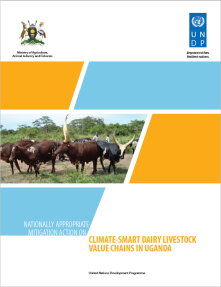Zambia: State Goes Climate Smart
GOVERNMENT has adopted climate smart agriculture approaches into the agricultural development planning and investment strategies in light of the climatic conditions. Agriculture and Livestock Minister
GOVERNMENT has adopted climate smart agriculture approaches into the agricultural development planning and investment strategies in light of the climatic conditions. Agriculture and Livestock Minister
The El Niño-Southern Oscillation (ENSO) in 2016 adversely affected Vietnam particularly the Mekong River Delta (MRD), where more than 90% of the country’s rice export is produced annually. To address this
This document presents some of the main routes by which R4D can contribute to agricultural transformation in the Sahel towards inclusive and sustainable economic growth, social development and resilience,
Climate change alters the agriculture production conditions and food security of developing countries, increasing the frequency and depth of risk to agricultural production and incomes. Policy-makers need
The Stepwise Climate Smart Investment Pathway (Stepwise) is an approach developed by the IITA research team in collaboration with partners. Stepwise breaks down the recommended best practices that many
This paper represents a first step in defining specific ways in which climate-smart agriculture can support the achievement of the Sustainable Development Goals and nationally determined contribution objectives.
Science–policy interfaces are critical in shaping agricultural and environmental governance. However, connecting science with policy has always been a challenge for both scientists and policymakers. In
Climate change poses serious threats to inclusive economic progress and poverty reduction. Strong countermeasures are required to increase the capacity of low-income people to mitigate their risk exposure
Tackling methane in the coal sector is a major opportunity for climate action that can also strengthen energy security. Experience shows that there are several steps countries can take today – using existing
Agriculture is the largest single source of environmental degradation, responsible for over 30% of global greenhouse gas (GHG) emissions, 70% of freshwater use and 80% of land conversion: it is the single
<p>India released its Long-Term Low Emission Development Strategy (LT-LEDS) at the UN Climate Change Conference (COP27), setting out a broad framework of how it proposes to meet its goal of achieving climate neutrality by 2070.</p>
This report shows how smart trade and investment policies, and regulatory cooperation in the Asia and Pacific region can help economies tackle climate change, recover from the pandemic, and support resilient
Environment, Water and Climate Minister Oppah Muchinguri-Kashiri has called for change in agricultural practices from conventional systems to climate-smart agriculture (CSA) which builds resilience and
Coastal communities and marine ecosystems can benefit from climate-smart agriculture practices, according to the findings of a new report from the International Fund for Agricultural Development (IFAD).

The Ministry of Agriculture, Animal Industry and Fisheries (MAAIF) of Uganda and UNDP have issued the Nationally Appropriate Mitigation Action on 'Climate-Smart Dairy Livestock Value Chains in Uganda'.
<p>Economies in the Asia-Pacific region need to urgently reduce greenhouse gas emissions, including to maintain their trade competitiveness as carbon taxes at borders threaten to rise, according to this new United Nations report </p>
It is now possible to calculate the amount of rainwater that can be harvested from the roof of houses thanks to a new smart phone app developed by UN Environment and the United Nations Educational, Scientific
This paper considers the intertwined challenges of food security and climate change, potential impacts of climate change on agriculture, and the impact of agriculture on climate. It further develops and
To achieve food security and agricultural development goals, adaptation to climate change and lower emission intensities per output will be necessary. This transformation must be accomplished without depletion
To achieve food security and agricultural development goals, adaptation to climate change and lower emission intensities per output will be necessary. This transformation must be accomplished without depletion